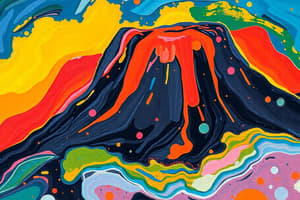Podcast
Questions and Answers
Which type of magma has a silica content ranging from below 45% to 52%?
Which type of magma has a silica content ranging from below 45% to 52%?
- Ultramafic magma
- Felsic magma
- Intermediate magma
- Mafic magma (correct)
What gases are commonly dissolved in magma?
What gases are commonly dissolved in magma?
- Hydrogen and nitrogen
- Methane and helium
- Carbon dioxide and sulfur dioxide (correct)
- Oxygen and nitrogen
At what temperature range do mafic magmas typically range?
At what temperature range do mafic magmas typically range?
- 1300 - 1800 degrees Celsius
- 500 - 900 degrees Celsius
- 1100 - 1600 degrees Celsius (correct)
- 800 - 1200 degrees Celsius
Which type of igneous rock forms from the solidification of lava at Earth's surface?
Which type of igneous rock forms from the solidification of lava at Earth's surface?
What is the density comparison between felsic and mafic magmas?
What is the density comparison between felsic and mafic magmas?
What is the main reason for magma to rise from within Earth?
What is the main reason for magma to rise from within Earth?
What is the primary factor determining the composition of magma?
What is the primary factor determining the composition of magma?
During which geological period was magma extremely common on Earth?
During which geological period was magma extremely common on Earth?
What happens to magma once it reaches the surface of Earth?
What happens to magma once it reaches the surface of Earth?
What is the role of radioactive elements like uranium and thorium in the formation of magma?
What is the role of radioactive elements like uranium and thorium in the formation of magma?
What is the primary location where magma can accumulate in magma chambers?
What is the primary location where magma can accumulate in magma chambers?
What geophysical process contributes to the formation of magma?
What geophysical process contributes to the formation of magma?
What is the temperature range of felsic magma?
What is the temperature range of felsic magma?
What contributes to the viscosity of magma?
What contributes to the viscosity of magma?
What is the primary composition difference between magma from mantle plumes and felsic magma?
What is the primary composition difference between magma from mantle plumes and felsic magma?
What is the main reason for the rise of magma within the Earth?
What is the main reason for the rise of magma within the Earth?
What is the composition of magma?
What is the composition of magma?
What happens to magma when it reaches the surface of the Earth?
What happens to magma when it reaches the surface of the Earth?
What is the source of heat that contributes to the formation of magma?
What is the source of heat that contributes to the formation of magma?
When was magma extremely common in Earth's geological history?
When was magma extremely common in Earth's geological history?
What contributes to the variation in the viscosity of magma?
What contributes to the variation in the viscosity of magma?
Where does magma primarily accumulate to form magma chambers?
Where does magma primarily accumulate to form magma chambers?
What causes the subducted plate material to melt and form magma at subduction zones?
What causes the subducted plate material to melt and form magma at subduction zones?
What is the distinguishing feature of felsic magma?
What is the distinguishing feature of felsic magma?
What contributes to the formation of oceanic crust at mid-ocean ridges and rifts?
What contributes to the formation of oceanic crust at mid-ocean ridges and rifts?
Flashcards are hidden until you start studying
Study Notes
Magma: Formation, Composition, and Characteristics
- Magma is liquid rock found beneath the surface of the Earth, primarily within the crust and upper mantle.
- Magma consists of a combination of liquid, solid, and semi-liquid substances, as not all minerals and elements within it have the same melting point.
- The viscosity of magma varies depending on its type, with some being more viscous and others flowing more easily.
- Magma is found in zones below crustal features such as mid-ocean ridges, subduction zones, rift valleys, and hot spot volcanoes, where it can accumulate in magma chambers.
- The temperature of magma below these surface features ranges from 490 to 1600 degrees Celsius, with the Earth's core being the hottest at 5,430 degrees Celsius.
- Magma forms through geophysical processes such as mantle plumes and convection currents, as well as through the subduction of plate material colliding with another.
- Mantle plumes originate at the boundary between the outer core and lower mantle, gradually rising to the base of the lithosphere, where they spread out and can melt rock due to the decrease in pressure.
- Magma created in upper mantle plumes can accumulate in large magma chambers and form hot spot volcanoes, while magma from convection currents can contribute to the formation of oceanic crust at mid-ocean ridges and rifts.
- Magma is also formed at subduction zones, where the increasing temperature and the presence of water cause the subducted plate material to melt, forming magma.
- The composition of magma varies depending on its formation, with magmas from mantle plumes having higher iron and magnesium concentrations, while felsic magma, with a high silica content, tends to be extremely viscous and adhesive.
- Felsic magma typically ranges in temperatures from 800 to 1,200 degrees Celsius, and is relatively low in iron content.
- Magma consists of different compounds and elements with varying melting points, leading to variations in its composition.
Studying That Suits You
Use AI to generate personalized quizzes and flashcards to suit your learning preferences.




